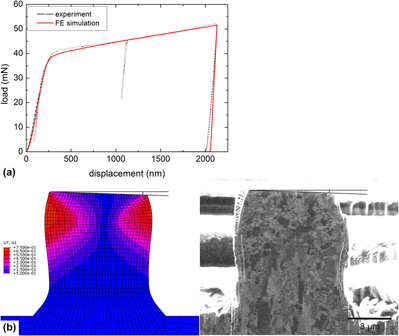Crossref Citations
This article has been cited by the following publications. This list is generated based on data provided by
Crossref.
Lacroix, R.
Kermouche, G.
Teisseire, J.
and
Barthel, E.
2012.
Plastic deformation and residual stresses in amorphous silica pillars under uniaxial loading.
Acta Materialia,
Vol. 60,
Issue. 15,
p.
5555.
Choi, In-suk
Gan, Yixiang
Kaufmann, Daniel
Kraft, Oliver
and
Schwaiger, Ruth
2012.
Measurement of Young’s modulus of anisotropic materials using microcompression testing.
Journal of Materials Research,
Vol. 27,
Issue. 21,
p.
2752.
Knorr, I.
Cordero, N.M.
Lilleodden, E.T.
and
Volkert, C.A.
2013.
Mechanical behavior of nanoscale Cu/PdSi multilayers.
Acta Materialia,
Vol. 61,
Issue. 13,
p.
4984.
Choi, In-Chul
Kim, Yong-Jae
Seok, Moo-Young
Yoo, Byung-Gil
Kim, Ju-Young
Wang, Yinmin
and
Jang, Jae-il
2013.
Nanoscale room temperature creep of nanocrystalline nickel pillars at low stresses.
International Journal of Plasticity,
Vol. 41,
Issue. ,
p.
53.
Zhang, J.Y.
Wang, Y.Q.
Wu, K.
Zhang, P.
Liu, G.
Zhang, G.J.
and
Sun, J.
2014.
Strain rate sensitivity of nanolayered Cu/X (X=Cr, Zr) micropillars: Effects of heterophase interface/twin boundary.
Materials Science and Engineering: A,
Vol. 612,
Issue. ,
p.
28.
Anderson, Peter M.
Carpenter, John S.
Gram, Michael D.
and
Li, Lin
2014.
Handbook of Nanomaterials Properties.
p.
495.
Khalajhedayati, Amirhossein
and
Rupert, Timothy J.
2014.
Emergence of localized plasticity and failure through shear banding during microcompression of a nanocrystalline alloy.
Acta Materialia,
Vol. 65,
Issue. ,
p.
326.
Yilmaz, Ezgi D.
Jelitto, Hans
and
Schneider, Gerold A.
2015.
Uniaxial compressive behavior of micro-pillars of dental enamel characterized in multiple directions.
Acta Biomaterialia,
Vol. 16,
Issue. ,
p.
187.
Schreijäg, Simone
Kaufmann, Daniel
Wenk, Moritz
Kraft, Oliver
and
Mönig, Reiner
2015.
Size and microstructural effects in the mechanical response of α-Fe and low alloyed steel.
Acta Materialia,
Vol. 97,
Issue. ,
p.
94.
Stoyanov, Pantcho
Linsler, Dominic
Schlarb, Tobias
Scherge, Matthias
and
Schwaiger, Ruth
2015.
Dependence of tribofilm characteristics on the running-in behavior of aluminum–silicon alloys.
Journal of Materials Science,
Vol. 50,
Issue. 16,
p.
5524.
Wheeler, J.M.
Armstrong, D.E.J.
Heinz, W.
and
Schwaiger, R.
2015.
High temperature nanoindentation: The state of the art and future challenges.
Current Opinion in Solid State and Materials Science,
Vol. 19,
Issue. 6,
p.
354.
Yilmaz, Ezgi D.
and
Schneider, Gerold A.
2016.
Mechanical behavior of enamel rods under micro-compression.
Journal of the Mechanical Behavior of Biomedical Materials,
Vol. 63,
Issue. ,
p.
183.
Valdevit, Lorenzo
and
Bauer, Jens
2016.
Three-Dimensional Microfabrication Using Two-photon Polymerization.
p.
345.
Shaat, M.
and
Abdelkefi, A.
2016.
Reporting buckling strength and elastic properties of nanowires.
Journal of Applied Physics,
Vol. 120,
Issue. 23,
Wheeler, Jeffrey M.
Kirchlechner, Christoph
Micha, Jean-Sébastien
Michler, Johann
and
Kiener, Daniel
2016.
The effect of size on the strength of FCC metals at elevated temperatures: annealed copper.
Philosophical Magazine,
Vol. 96,
Issue. 32-34,
p.
3379.
Kumar, Amritesh
Ensslen, Charlotte
Krüger, Antje
Klimenkov, Michael
Kraft, Oliver
and
Schwaiger, Ruth
2017.
Micromechanical study on the deformation behavior of directionally solidified NiAl–Cr eutectic composites.
Journal of Materials Research,
Vol. 32,
Issue. 11,
p.
2127.
Schwark, Tabea
Kraft, Oliver
and
Schwaiger, Ruth
2017.
The boundaries of soft magnetic composites reveal their complexity in compression and bending tests at the micro-scale.
Materials Science and Engineering: A,
Vol. 684,
Issue. ,
p.
270.
Samaeeaghmiyoni, Vahid
Idrissi, Hosni
Groten, Jonas
Schwaiger, Ruth
and
Schryvers, Dominique
2017.
Quantitative in-situ TEM nanotensile testing of single crystal Ni facilitated by a new sample preparation approach.
Micron,
Vol. 94,
Issue. ,
p.
66.
Gola, Adrien
Zhang, Guang-Ping
Pastewka, Lars
and
Schwaiger, Ruth
2019.
Surface flaws control strain localization in the deformation of Cu|Au nanolaminate pillars.
MRS Communications,
Vol. 9,
Issue. 3,
p.
1067.
Jakob, S.
Lorich, A.
Eidenberger-Schober, M.
Knabl, W.
Clemens, H.
and
Maier-Kiener, V.
2019.
Microstructural Characterization of Molybdenum Grain Boundaries by Micropillar Compression Testing and Atom Probe Tomography.
Practical Metallography,
Vol. 56,
Issue. 12,
p.
776.



